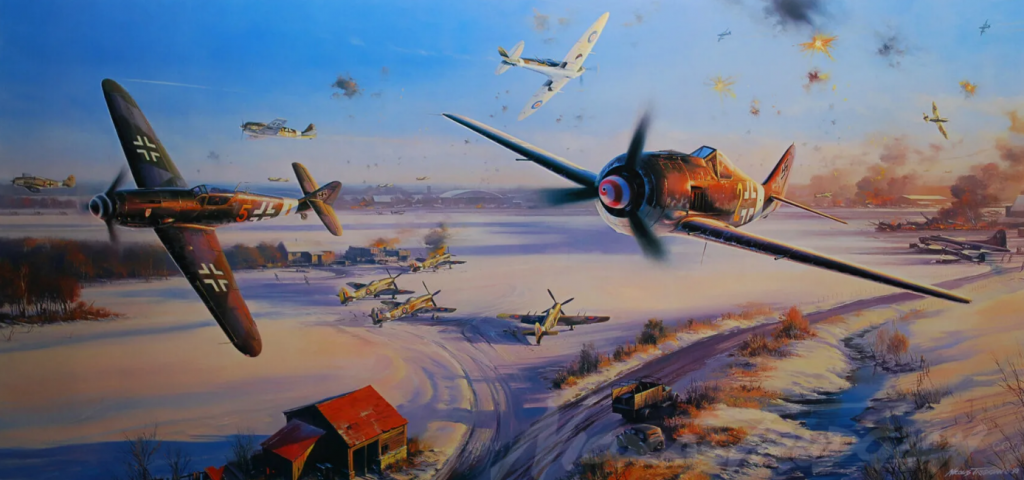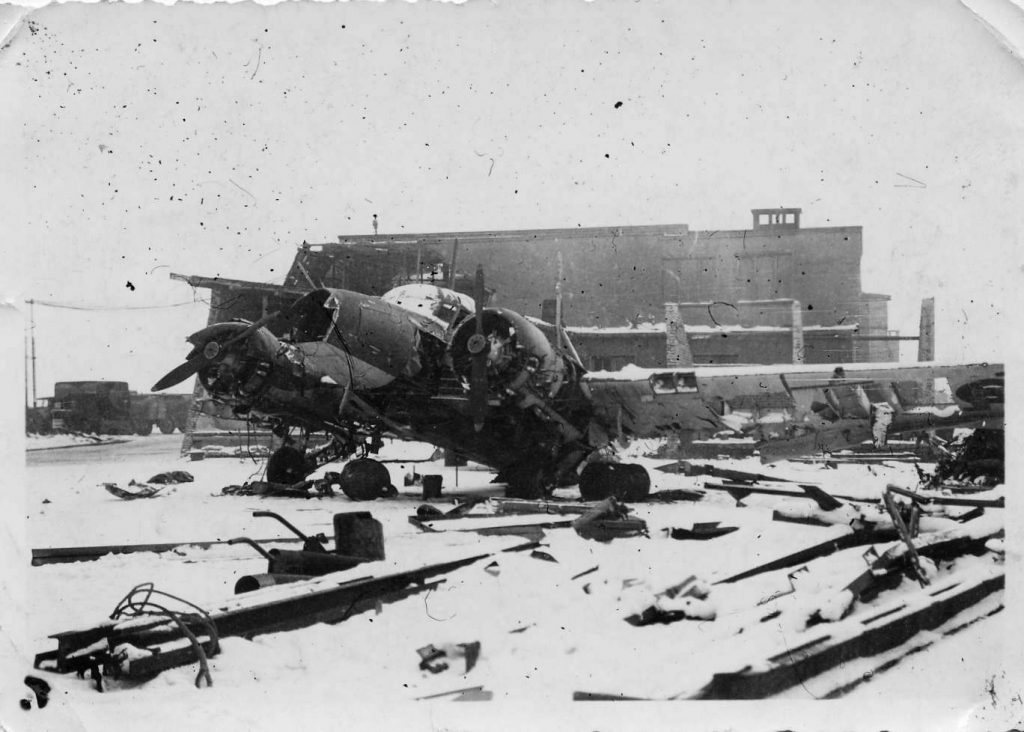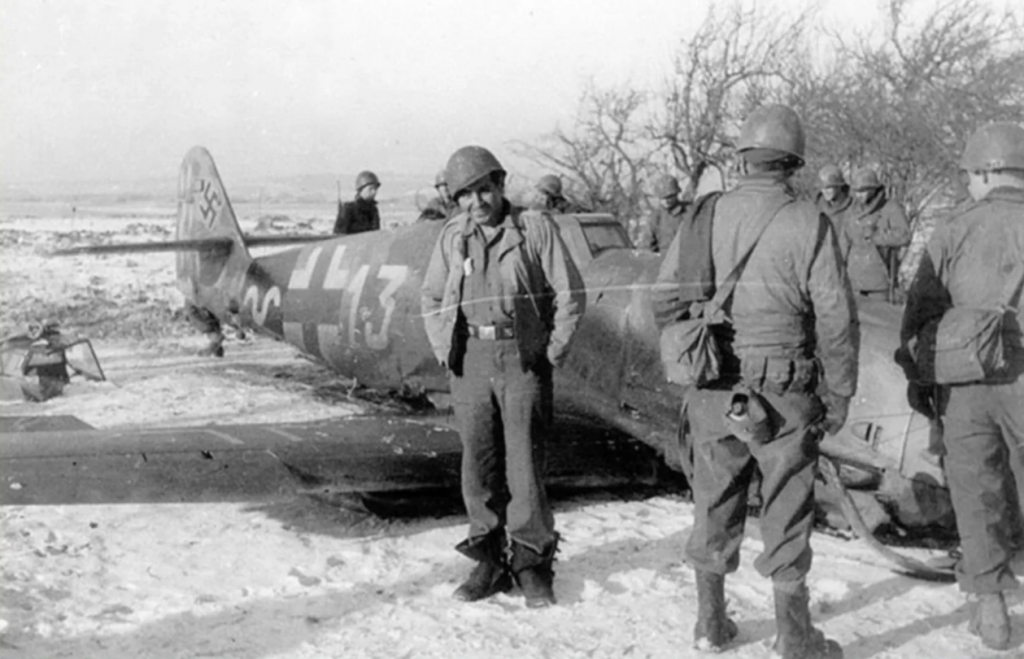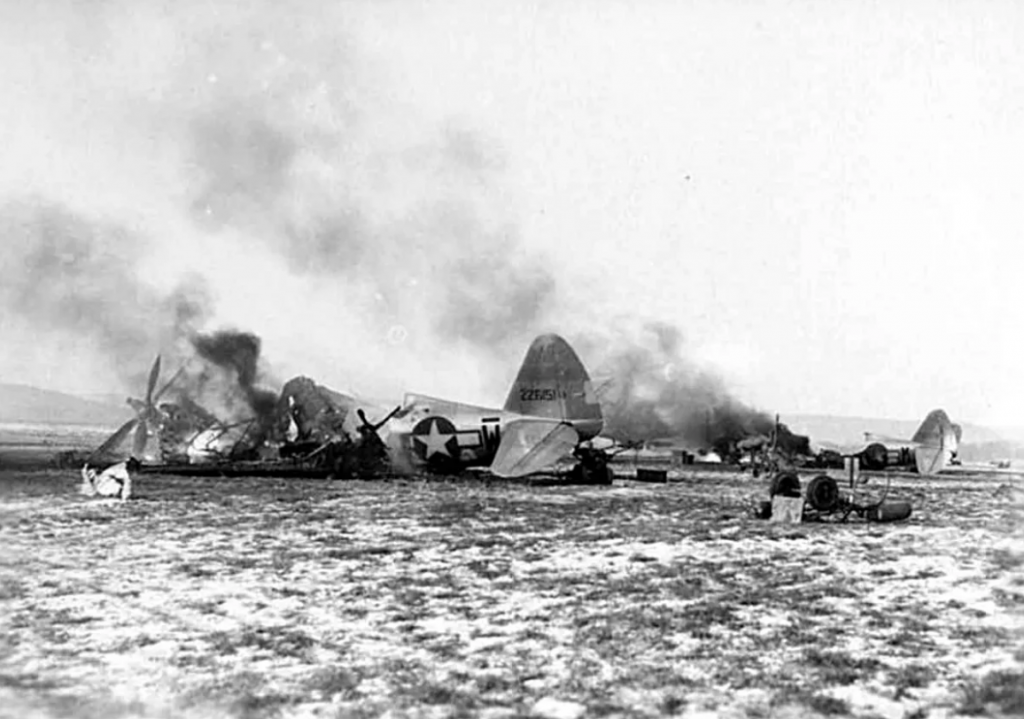Background of Operation Bodenplatte
By the end of 1944, the outcome of the war was no longer in doubt. Nevertheless, the Germans were able to show that they can still hit the enemy very hard and even inflict local defeat on him. First of all, this applied to the Wehrmacht and its offensive in the Ardennes, but the Luftwaffe were also able to successfully carry out their operation, thus celebrating the onset of the New Year.
 In the summer of 1944, the German fighter units of the Western Front actively fought both over the contact line of troops in France and later Belgium, and in the air defense of the Reich, repelling the raids of four-engine bombers on Germany, while suffering serious losses. By the beginning of October, the Allied offensive had finally fizzled out, and the front had stabilized, and at the same time the tension of the air battles had noticeably decreased. This made it possible to divert a number of air units for reorganization to Central Germany, and replenish and rearm the rest without withdrawing to the rear. At the same time, almost all the remaining groups of twin-engine “destroyers” were reorganized into ordinary “hunters” and re-equipped with single-seat fighters.
In the summer of 1944, the German fighter units of the Western Front actively fought both over the contact line of troops in France and later Belgium, and in the air defense of the Reich, repelling the raids of four-engine bombers on Germany, while suffering serious losses. By the beginning of October, the Allied offensive had finally fizzled out, and the front had stabilized, and at the same time the tension of the air battles had noticeably decreased. This made it possible to divert a number of air units for reorganization to Central Germany, and replenish and rearm the rest without withdrawing to the rear. At the same time, almost all the remaining groups of twin-engine “destroyers” were reorganized into ordinary “hunters” and re-equipped with single-seat fighters.
In November, in the units of the first line (60 groups of 19 fighter squadrons), there were already more than 3,000 single-seat vehicles and the commander of fighter aviation, Lieutenant General Adolph Galland presented to the leadership the idea of using this armada in one coordinated operation called “Grosse Schlag” (“Big Blow” ).
The idea was to send 2,000 fighters to intercept during a major raid on Germany, which would strike at bombers heading towards the target. Then the fighters that remained intact and serviceable after the battle (at least 500 of them were expected), after refueling and replenishment of ammunition, would rise to intercept the returning “fortresses”, and twin-engine interceptors of the night fighter squadrons at the same time would begin to hunt for damaged and lagging bomb carriers trying to return to the front line, or seeking salvation from neutrals.
The expected result of the operation was the destruction of 400-500 bombers and the resulting suspension of further raids on Germany at the cost of the loss of about 400 of its own aircraft and 100-150 pilots.
In November-December, this plan was discussed at several meetings, but they did not intend to carry it out, because they had already decided to use the assembled forces to strike not against heavy bombers, but against Allied fighter-bombers at front-line airfields.
Back in September, the headquarters of the Luftwaffe was notified of the upcoming offensive in the Western direction. Especially for him, in October, the “front-line” grouping was reinforced with several squadrons transferred from the Reich air defense, and on November 14, Goering gave an order for aviation actions to support the offensive in the Ardennes, which, among other measures, included a massive attack on enemy airfields. Four days later, this strike was included in the general plan of Operation Watch on the Rhine, but without setting a specific date or any time reference at all.

The plan of the operation, codenamed “Bodenplatte” (Bodenplatte – base plate), was finally finalized on December 4 at a meeting of the commanders of the fighter groups and squadrons of the Western Front. Each squadron was assigned its own airfield for attack (some two or even three). The raids were to be carried out simultaneously and with all available forces. The pilots had to make 2-4 approaches to the target, in order to achieve surprise on most of the route, following the leader aircraft (two Ju 88Gs assigned to each fighter group) at an altitude of 30-100 meters with complete radio silence. route points on their territory were supposed to be marked with special smoke signals.
Photo control of the results of the attack was ordered to be carried out by short-range reconnaissance aircraft (“photographic” versions of Bf 109) flying in general combat formations with fighters and by separate jet bombers and fighter-bombers operating separately. The latter were also supposed to cover the retreat of piston engines from possible attacks by enemy aircraft.
The study of flight plans and the attack itself was left to the commanders of squadrons and groups. The performers were required to strictly observe secrecy, and, looking ahead, the preparation was really hidden from the enemy. But with the information being brought to the rank and file pilots, the command in some places went to two extremes: in some groups the crews were notified immediately and in the first half of December they began to work out the attack technique on special mock-ups of airfields, in others they brought information about the target of the attack just a couple of hours before departure. But in most cases, the pilots were informed the day before the attack.
Meanwhile, on December 16, German troops, taking advantage of the worsening weather, began “Watch on the Rhine”, but only a week later their advance stalled. By that time, the activity of the Allied aviation had cleared up, and with it the losses of the Luftwaffe had seriously increased. The officers aware of the Bodenplatte plan already considered this operation canceled, since, logically, it made sense to strike the airfield either before the start of the offensive or immediately after the weather improved, but the high command had a different opinion on this matter. In the middle of the day on December 31, two code signals passed through the authorities: “Varus” (the operation will take place within 24 hours) and “Teutonicus” (it is necessary to inform the pilots and prepare the planes for departure), in the late afternoon, supplemented by a third: “Herman January 1 09: 20 “(Date and time of impact).
In accordance with the plan, the operation involved all the fighter and assault units at the disposal of the Luftwaffe West Command: 34 groups of 11 fighter squadrons and three groups of one assault squadron. According to the state, they were supposed to have 2,484 aircraft and an equal number of pilots, but in practice, after the losses incurred, 1,689 pilots (68% of the staff) were available, of which 1,054 (42%) were recognized as combat-ready, and 1,312 aircraft (53%), including including 921 (37%) serviceable.
If you look at the modifications, then (counting only serviceable ones) there were 258 Fw 190A-8, 20 Fw 190A-9, 167 Fw 190D-9, 75 Fw 190F-8, 2 Bf 109G-6, 52 Bf 109G-10, 255 Bf 109G-14 and G-14 / AS and 92 Bf 109K-4. Practical combat effectiveness (ready-to-fight pilots on serviceable fighters) in fighter squadrons varied from 25 to 48% of the regular strength, and for attack aircraft it was 57%.
 The operation was initiated by four jet Ar 234B-2s from the Combined Combat Use Squadron of Group III./KG 76, which set off on the night of January 1 for weather reconnaissance along the Rotterdam – Antwerp – Brussels – Liege – Cologne route. In order not to fly just like that, they delivered a “passing cargo” in the form of one SC500 and three SC250s (one bomb per plane) to Brussels and Liege. The weather was favorable for the morning raid and the plan remained in effect.
The operation was initiated by four jet Ar 234B-2s from the Combined Combat Use Squadron of Group III./KG 76, which set off on the night of January 1 for weather reconnaissance along the Rotterdam – Antwerp – Brussels – Liege – Cologne route. In order not to fly just like that, they delivered a “passing cargo” in the form of one SC500 and three SC250s (one bomb per plane) to Brussels and Liege. The weather was favorable for the morning raid and the plan remained in effect.
After the compilation of the report on December 31, JG 26 received a couple of dozen new fighters, and at night the mechanics of different squadrons were able to return several more aircraft to service. However, in other units, for various reasons, some of the aircraft and pilots ready for battle were not involved. There were also incidents typical of aviation, with technical problems that appeared at the last moment. As a result, on the morning of January 1, only 774 fighters, 50 attack aircraft, 6 jet bombers, 22 jet fighter-bomber aircraft, 33 photo reconnaissance aircraft based on Bf 109G and 44 leader Ju 88G left on a raid on Allied airfields – a total of 852 strike vehicles and 77 support and control aircraft.
Several aircraft were lost in accidents and disasters immediately after takeoff, a couple dozen more soon returned due to various malfunctions on board, and the rest continued their flight to the front.
Some squadrons went with a common armada of aircraft, others in separate groups, but along the same route, while others chose different routes for different groups. In most cases, the flight altitude for all units was the same, but JG 6 and JG 11 allocated a cover group (on the Bf 109), which stayed slightly higher than the Fw 190 drums. In the first, they even developed a clear plan for the interaction of different groups during the attack, but, running ahead, this plan lasted only until the first shot of the enemy.
The secrecy regime, which ensured the surprise of the attack, played a bad joke with the Germans: the anti-aircraft units were not informed about the planned flights, and when in Holland, where no German planes had appeared for a couple of weeks, the anti-aircraft gunners saw a large group of fighters, they took them for the enemy. The low altitude of the “targets” left too little time for reasoning, and the arrows immediately pressed the trigger.
Only the flight of JG 6 did without such a “greeting”, and JG 1 lost 4-5 fighters and two pilot Ju 88 fighters, JG 26 – 6-8 fighters, JG 27 – two, JG 54 – one, and the JG 77 pilots were lucky to get off with a slight fright.
A group of low-flying aircraft is a good target not only for MZA, but also for enemy fighters, if, of course, they do not fly too high. When setting the date for the operation, the Luftwaffe command undoubtedly hoped that the celebration of the New Year would have a detrimental effect on the combat readiness of the enemy. The holiday was indeed celebrated on both sides of the front, but the pilots assigned to the morning sorties were strictly prohibited from celebrating and drinking alcohol for a long time. Therefore, the pilots were sober and angry.
During tactical reconnaissance over Holland, two Spitfires Mk.XIV from RAF 2 Squadron stumbled upon a formation of Messerschmitts I. and II./JG 27. Coming from the sun, the British dived onto the trailing pair and, having shot down one aircraft, with a candle went up, and were not noticed by most of the Germans.
A little later, in the Antwerp area, 12 Spitfires Mk.IX and Mk.XVI from the 308th (Polish) squadron, returning from an assault strike, stumbled upon a group of Fw 190D-9 from I./JG 26 and III./JG 54. Several Poles from a dive attacked the tail of the enemy column, immediately knocking down two Doras, and two more Germans themselves crashed into the ground on an unsuccessful evasion maneuver.
 And in the southern sector of the front III./JG 53, heading straight from its airfield to the target, it was not possible to reach the front line, because 12 P-47D Thunderbolts from the 367th squadron of the 358th suddenly fell on it a fighter air group that carried out “armed reconnaissance” and noticed “more than 30 Bf 109, Fw 190 and two Me 410”… In a fleeting battle, the Americans shot down several German planes without casualties, while the rest had to drop outboard gas tanks. This put an end to the possibility of flying to the target and back, so the German group that had gathered after the end of the battle turned in the opposite direction. Luck that day completely turned away from III./JG 53: on the retreat, a dozen Thunderbolts from 366 Squadron of the same 358 group of group stumbled upon it … The result of the battle was eight lost Bf 109 against one shot down P-47, and a completely disrupted raid on Éten airbase.
And in the southern sector of the front III./JG 53, heading straight from its airfield to the target, it was not possible to reach the front line, because 12 P-47D Thunderbolts from the 367th squadron of the 358th suddenly fell on it a fighter air group that carried out “armed reconnaissance” and noticed “more than 30 Bf 109, Fw 190 and two Me 410”… In a fleeting battle, the Americans shot down several German planes without casualties, while the rest had to drop outboard gas tanks. This put an end to the possibility of flying to the target and back, so the German group that had gathered after the end of the battle turned in the opposite direction. Luck that day completely turned away from III./JG 53: on the retreat, a dozen Thunderbolts from 366 Squadron of the same 358 group of group stumbled upon it … The result of the battle was eight lost Bf 109 against one shot down P-47, and a completely disrupted raid on Éten airbase.
Excluding the unsatisfactory results of the battles, all the episodes described above can be attributed to the accidents inevitable in the war, but obvious planning errors during the operation also took place. For example, if on the “northern front” the Allied air defense turned out to be rather weak, then on the “southern”, where the main battles were going on at that time, it was noticeably stronger. And the area southeast of Liege, known to the Americans as the “alley of buzzing bombs”, was literally flooded with stationary and mobile anti-aircraft installations, “working” on the V-1 projectiles flying there. And it was through this area that the routes for JG 2 and JG 4 were laid.
The Richtofens were the first to go deeper into the alley, and their fighters, one after another, began to fall to the ground. In total, anti-aircraft gunners shot down at least 22 aircraft out of 80 available at the time of takeoff and completely destroyed the formation of all three groups, turning it into a set of flights, pairs and single vehicles.
Some of the pilots then stormed the first targets they came across and dropped out of the battle, but the rest continued their flight to the target. However, they never reached the target of attack assigned to him – Saint-Thron airbase (A-92), but joined JG 11 in her attack on Ash and, probably, Ophoven airfields. The damage they inflicted could hardly justify the losses incurred by the squadron during the operation: no less than 37 downed aircraft plus a couple of those who sat “on their belly” on their territory. And according to the final report, the losses were even more noticeable: 43 vehicles with damage of 50% and more.
JG 4 also came under anti-aircraft fire in the same area. Its IV group, after the first losses, in violation of the order, climbed to an echelon of 1000 meters, hiding behind the clouds, and then its remnants (8-10 machines out of 17) continued their flight by reckoning. At the estimated time, the leader led her into an attack on the airfield found below, which in reality turned out to be Saint-Throne, and not Le Culot (A-89) expected by the pilots. Despite the small detachment of forces, the attack turned out to be quite successful: the Allies (mostly Americans, but several Britons also ended up there) lost at least 15 aircraft there, destroyed and 37 damaged.
After breaking through the air defense zone, only four damaged Fw 190s remained from the formation of Group II, which carried out a couple of attacks on some American airfield (probably it was Ash) and, having lost another car there, withdrew from the battle.
Consolidated group of I. and III./JG 4, falling under anti-aircraft fire. just turned home. A few days later, its leader, the commander of the third group, Major (he was awarded this rank on January 1), Friedrich Eberle, an ace with 33 victories, was put on trial for cowardice in the face of the enemy. Later, Eberle was acquitted, but removed from the front.
Raid SG 4, which was also supposed to storm Saint-Throne, ended in a scandalous failure. At first, her III group almost crashed into the convoy of JG 11 and lost formation. Then the leaders of the groups, having arrived at the gathering point, did not find the commander and the “pilots” there. After circling for some time and unable to communicate with the command by radio, the attack aircraft returned to the bases.
As a result, out of 50 pilots, only the commander himself performed the mission, three III./SG 4 pilots joined him and two of their comrades who joined JG 11. Of the first four, three were shot down by anti-aircraft fire, the fourth returned damaged, and from the remaining pair, one pilot Allied aircraft “dropped” to the ground.
Later, many complaints were also found regarding the intelligence data, which failed to uncover some of the new Allied airfields. For example, JG 6, precisely following a route that bypassed all known airfields, suddenly went to the unmarked Khes airbase (B-88), losing the advantage of surprise in the attack and getting unnecessary enemies that otherwise might not even be recognized. what is the attack going on.
The fact is that the stake on the simultaneous strikes and low-altitude flight worked perfectly, and the Allied aviation commanders learned about the presence of the enemy only when the Germans flew directly over their airfield. The pairs on duty and the units, where they were at all, did not have time to start in time, and all the air battles were conducted by the pilots who were already in the air during the German raid (who had just taken off or were returning from a combat sortie). In addition, the “horizontal” links between different wings and fighter groups were poorly developed and flight leaders found it easier to recall their fighters from combat missions than to ask for help from neighbors. At the airfields, over which the Germans did not appear on January 1, they learned about the massive attack carried out not by radio, but from the columns of smoke that appeared on the horizon.
The unsuccessfully laid route JG 6 cost the Germans the entry into battle of three extra groups of Mk.IX Spitfires (from the 401st, 412th and 442nd RAF squadrons recalled from the combat sortie) and, accordingly, extra losses as for JG 6 itself and for other squadrons.
Navigation in low level flight is a challenge in itself, and with such distractions as anti-aircraft fire and enemy fighter attacks, it is fraught with serious errors. So the leaders of the JG 6 groups did not notice how they passed the turning point of the route, moving away from their target – Volkel airbase (B-80).
But ahead and to the right along the course, a large column of smoke rose, and the pilots I./JG 6 went there, joining JG 3 in the attack on Eindhoven (B-78), and the II group and most of the third went to another airfield that had not been opened by reconnaissance – base Helmond (B-86) and began to attack it.
To their misfortune, this airfield turned out to be empty, but at the same time it was well covered by anti-aircraft guns, so “all the steam went into the whistle.” And then the British fighters began to catch up, including those that took off from Hes, and the Germans had to pay in blood for all the mistakes.
Another “scared” airfield was Wunsdrecht (B-79), over which, either due to a small navigational error, or because of an unsuccessful route, JG 77 passed. True, in this case, this error did not lead to negative consequences, because the alert unit on duty did not detect the air enemy and simply “held an umbrella” over the base.
Among the incidents associated with poor intelligence work, one can also refer to the distraction of a third to half of the pilots of the JG 11 squadron heading to Asch to attack the new airfield, Ophoven, which they unexpectedly discovered. In itself, this was not critical – the squadron’s forces were quite enough for two effective attacks, but the Ophoven attack, on which the Spitfire wing was based, turned out to be completely ineffective – only one destroyed and five damaged fighters, plus minor damage to several transport Dakotas, and the main part of the squadron was unlucky, on the approach to the target, head-on, to meet eight P-47Ds from the 390th squadron of the 366th fighter air group, which had just assembled after takeoff and went to check who the anti-aircraft guns were shooting at.
Having dropped the bombs, the Americans went on the attack, and literally at the same moment, already under the sound of the air raid siren, a dozen P-51s from the 487th squadron of the 352nd fighter air group began to take off, which also immediately entered the battle. The numerical superiority was on the side of the Germans, but training and great freedom of action were on the side of the Americans. Even if they could not completely prevent the attack, they minimized its effectiveness (only three damaged aircraft and the destroyed “remains” of the long-wrecked B-17) and emerged as the undoubted winners of the air battle, shooting down from 9 to 12 Germans at the cost of losing only one Thunderbolt “.
But sometimes you can get an unsatisfactory result even if everyone did everything correctly and did not make mistakes. For example, 4./JG 1, as it was ordered, went to Ursel, and I./JG 26 and III./JG 54 – to Grimbergen. But both of these normally busy bases were empty that morning, save for a few cars that happened to be there. The Germans, of course, destroyed or damaged all of them, but these successes did not pay off the costs incurred.
There were, of course, undoubted successes. For example, pilots JG 27 and IV./JG 54 at Melsbrook airbase (B-58) destroyed about 60 aircraft and damaged 30 more. even more significant.
In Eindhoven, the busiest of the attacked bases, the Allies lost at least 44 aircraft destroyed and 60 damaged. Moreover, the most destructive was not the first wave of the attack, carried out by JG 3, but the second, carried out by the pilots of the “stray” I./JG 6.
Evere airfield (B-56) was also jammed with equipment, and the attackers II. and III./JG 26 destroyed 41 enemy aircraft and damaged 20 seriously and 7 more easily. The anti-aircraft cover of this air base was weakened, and the attackers quickly suppressed it.
Assault on the remaining four bases: Metz-Frekati (Y-34) by the headquarters forces, II. and IV./JG 53, Saint-Denis-Westrem (B-61) by II./JG 1, Maldegem (B-65) by squadron headquarters, the first three staffs and III./JG 1 and Derne (B-70) forces of JG 77 had less success and in the first two cases were worth considerable losses of their own.
The last, 15th airfield to be attacked, was the Gilse-Reyen airbase (B-77). According to British data, it was attacked by about 30 enemy aircraft, mostly piston-based – most likely, pilots JG 26 and JG 77 strayed off course, but according to the plan, this was a target only for jet aircraft.
Each of the Ar 234B-2 of composite squadron III./KG 76 carried an AB500 container with 24 SD15 bombs, and each of the Me 262A-2a KG 51 carried a pair of 250 kg bombs, which means, in theory, they could cause more damage than piston “shooting attack aircraft”. In practice, everything was limited to one destroyed aircraft and several damaged ones, which is not surprising, because in reality only a few aircraft were bombed on this base, and the rest, as it turned out during the post-flight analysis, attacked some smaller airfield in the same area.
For the pilots of the Sturmfogels, other targets were also assigned – for example, Eindhoven and, perhaps, several more, since the Allies noted the Me 262 attack not only on the two airfields, but also on Helmond and Ophoven.
In addition to bombing, the pilots of the Messerschmitts also made assault approaches, but they openly sabotaged the mission to cover the withdrawal of the pistons, considering it impracticable, and, using high speed, simply evaded clashes. But they completed the plan for aerial photography successfully and then returned to the base without loss.
Their colleagues – “pistons” could only dream of such a level of safety. In total, no less than 262 ~ 267 fighters and attack aircraft were lost during Operation Bodenplatte, of which 32 ~ 35 landed on the forced on their territory and, in theory, could then return to service. A summary with standard Luftwaffe damage percentages shows 271 aircraft lost (damage 50% or more) and 65 damaged (49% or less).
The losses were very large, especially for one operation lasting only a few hours, but they could not seriously spoil the statistics at least for a decade, because there were already similar precedents. For example, on December 23-25, in three days of the most intense air battles, the same units lost a total of 363 fighters.
To the losses of fighters and attack aircraft, it is necessary to add 8 shot down Ju 88s and an unknown, but hardly more than ten vehicles, the number of scouts. In total, this gives about 290 lost and 80 damaged vehicles.

JG 77 was knocked out of the general statistics by the minimum level of losses – 16.9% of the number of those participating in the operation, while for the rest of the units this level varied from 25 to 46.4%. And if we count the unknown losses and landings “on the belly”, and aircraft with damage of 50-100%, then JG 77 will have 18.6%, and the rest from 25 to 51.2%. That is, at best, every fifth aircraft went into “no return”, and at worst every second of those participating in the operation. It remains only to see what results were achieved at the cost of such losses.
Photo control data were available only for 8 airfields, and in other cases the report was written at the request of the pilots. Total: 352 destroyed and 106 damaged single-engine aircraft, 28 and 6 twin-engine and 22 and 2 four-engine, or a total of 402 destroyed and 114 damaged enemy aircraft. In addition, in air battles, the pilots scored 49 confirmed air victories, known from the “named” list, but in the final reports this number increased to 55 (January 3) and 65 shot down and 12 presumably downed (February 25).
Based on the ratio of victories and losses, from the point of view of the Luftwaffe, Operation Bodenplatte was a victory, albeit at a dear price. It remains only to compare the German reports with the data of the enemy.
The easiest way to check the aerial victories: in aerial battles on the morning of January 1, the British and Americans lost only 14 aircraft downed and 5 on their belly (3 of them due to full fuel consumption). And of the German losses, at least 64 shot down and 5 downed on forced accounted for exactly losses in air battles, and for another 16 shot down the cause could be both air combat and anti-aircraft fire, plus there is simply no information on 21 lost fighters.
The Anglo-Americans usually also “didn’t regret it,” but in this case their “overclimb” turned out to be quite small: the pilots were credited with a total of 104 confirmed aerial victories known from the “named” list, and in the subsequent summary the overall result was cut to 97.
Anti-aircraft units in the same final report counted 129 victories, which is also very close to their real successes: the Germans accurately attribute 86 downed and 11 planes that have landed on their belly at the expense of anti-aircraft artillery, 23 and 3 more presumably.

Due to the fact that at the attacked airfields there was equipment that belonged not only to the main “owners” of these air bases, but also to “completely outside” aviation units and formations, there is no exact data on losses on the ground.
It is reliably known about 143 destroyed and 139 damaged single-engine aircraft, 74 and 12 twin-engine and 15 and 5 four-engine, which in total gives 232 destroyed and 156 damaged aircraft. But according to indirect data, the total losses were 15% higher – about 290 destroyed and 180 damaged, that is, when calculating the “ground” victories, the Germans were not too mistaken.
Thus, the “victory on points” in this operation was still won by the attackers. But a significant part of the “foreign” aircraft caught at the attacked airfields landed there already having damage of varying severity, including those beyond repair. And if we recall that the strike was aimed at destroying the enemy’s tactical aviation, and consider only the loss of combat units of the British 2 Tactical and American 9th Air Forces (about one hundred and fifty destroyed and the same number of damaged ones), then the victory begins to look more like defeat …
At the warehouses in England, the Allies then accumulated a sufficiently large number of aircraft to easily compensate for the damage caused by the Germans, fully restoring the staffing and combat capability of all affected units in a period from two days to a week.
In Germany, the stocks of equipment were not as large as those of the Allies, but even there it did not take much time to replenish the losses – only one or two weeks. The situation was worse with the personnel: in the long list of pilots who died and were captured on the morning of January 1, there are seven dozen fighter pilots with a large number of combat missions behind them, including three squadron commanders, five group commanders and 14 squadron commanders. And they were replaced by recent flight school graduates and retrained bomber pilots, which further lowered the average level of training of fighter pilots, which was already inferior to the enemy.
Thus, the operation “” not only did not achieve the expected results, but also became the next step of the Luftwaffe on the way to defeat.






